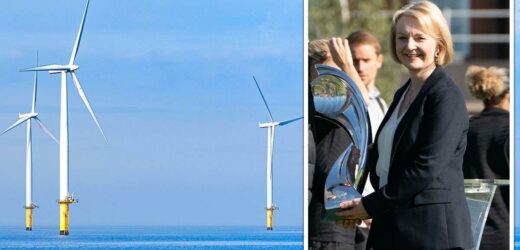Alice Beer gives energy saving tips on This Morning
We use your sign-up to provide content in ways you’ve consented to and to improve our understanding of you. This may include adverts from us and 3rd parties based on our understanding. You can unsubscribe at any time. More info
The UK is set for a massive boost to its domestic energy supplies, as SSE, along with Norway’s Equinor and Italy’s Eni, are reportedly considering expanding the Dogger Bank wind farm. Construction work is now underway on the £3.6billion project, which will be built in three stages and will collectively be the world’s largest wind farm. However, the companies involved are looking to expand and add a fourth phase, Dogger Bank D, which will allow the massive project to generate even more electricity. Under current plans, each of the phases will have an installed generation capacity of 1.2GW and installing a combined capacity of 3.6GW, which is enough to power 6 million homes.
The energy companies are now conducting surveys at an offshore site where the partners want to develop Dogger Bank D, which would bring Dogger Bank Wind Farm’s total capacity to nearly 5 GW if built, which could likely power approximately 8 million homes.
A spokesperson for the project told Offshorewind.biz: “SSE Renewables and Equinor are currently assessing seabed for the potential of expanding Dogger Bank Wind Farm, which is currently under construction, with an additional phase, Dogger Bank D. The potential project is supported by a grid connection for up to 1320MW.”
The surveys, which began in August, are expected to be completed next month. In May, the project completed a major milestone, as it saw work to install the HVDC export cable, which will connect the first phase of the wind farm, more than 130km off the coast to a landfall point at Ulrome, in East Riding of Yorkshire.
According to a statement by SSE, Dogger Bank Wind Farm will be the UK’s first HVDC connected wind farm and will be vital in learning how to transport renewable energy at greater distances.


Steve Wilson, project director at Dogger Bank said: “This is an exciting time for everyone involved in this project as we celebrate installing the first nearshore HVDC export cable safely and on time.
“With the first foundations due to be installed later this year and the first turbines scheduled for installation in 2023, we’re now well on our way to achieving first power from this unrivalled global renewable energy asset. I’d like to extend my thanks to all those who’ve worked incredibly hard to reach this major offshore milestone.”
The UK is rich in offshore wind energy and has been capturing that potential by building a number of major wind farms in the North Sea and the Celtic Sea.
In the Government’s Energy Security Strategy, the UK announced an ambition to deliver up to 50GW by 2030, including up to 5GW of innovative floating wind.

Analysis by the Carbon Brief noted that as the cost of gas skyrocketed following Russia’s invasion of the Ukraine, wind power had now become nine times cheaper than gas.
They found that the Government had granted a number of contracts to offshore wind farm producers to generate electricity at an average price of £48 per megawatt-hour (MWh). This is nine times cheaper than the £446/MWh current cost of running gas-fired power stations.
The UK has enormous potential to generate wind energy, which is evident by the fact the current largest wind farm, Hornsea 2 became fully operational last month, generating power about 55 miles off the coast of Yorkshire.
The wind farm will now generate enough electricity to power about 1.3 million homes, enough to run a city the size of Manchester. Renewable energy has gone from 11 percent of the country’s energy mix to 40 percent, with offshore wind making up the bulk of it.
DON’T MISS:
Downing Street accused of indifference’ about vaccines [REPORT]
Europe at risk of being cut off from rest of world by Putin [INSIGHT]
Energy outage as undersea cables near Nord Stream pipeline cut [REVEAL]

Patrick Harnett, programme director for the Hornsea 2 wind farm told BBC News: “The UK is one of the world leaders in offshore wind. This is very exciting after five years of work to have full commercial operations at the world’s largest offshore wind farm.”
Speaking during a visit to Dorset, then-Prime Minister Johnson promised to deliver “absolutely shedloads of wind power” as he sought to pin the blame for high gas prices on Russia’s invasion of Ukraine.
The construction of the wind farm would add a critical boost to the UK’s energy security, as the country desperately scrambles to prevent a blackout this winter by shoring up electricity supplies.
The National Grid warned last week that the UK could face planned three-hour blackouts if it fails to secure enough electricity from Europe this winter.
Source: Read Full Article


